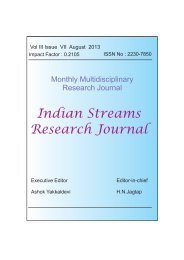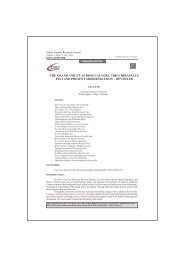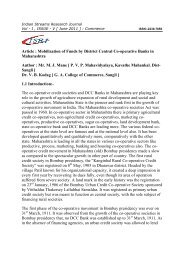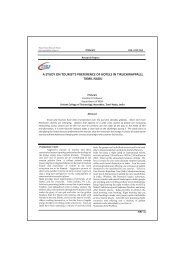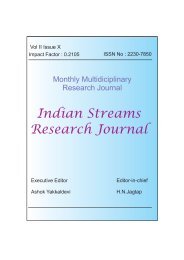Article : Volumetric and viscometric studies on N, N-dimethyl ...
Article : Volumetric and viscometric studies on N, N-dimethyl ...
Article : Volumetric and viscometric studies on N, N-dimethyl ...
- No tags were found...
Create successful ePaper yourself
Turn your PDF publications into a flip-book with our unique Google optimized e-Paper software.
Indian Streams Research Journal<br />
Vol - I , ISSUE - V [ June 2011 ] : Chemistry<br />
ISSN:-2230-7850<br />
<str<strong>on</strong>g>Article</str<strong>on</strong>g> : <str<strong>on</strong>g>Volumetric</str<strong>on</strong>g> <str<strong>on</strong>g>and</str<strong>on</strong>g> <str<strong>on</strong>g>viscometric</str<strong>on</strong>g> <str<strong>on</strong>g>studies</str<strong>on</strong>g> <strong>on</strong> N, N-<strong>dimethyl</strong> acetamide <str<strong>on</strong>g>and</str<strong>on</strong>g><br />
ethanol binary mixtures at different temperatures<br />
Author : A.G.Peshwe [ Netaji subhashCh<str<strong>on</strong>g>and</str<strong>on</strong>g>ra bose colleges, N<str<strong>on</strong>g>and</str<strong>on</strong>g>ed ]<br />
B.R. Arbad [ Dr. Babasaheb Ambedkar Maradwada University, Aurangabad<br />
]<br />
Abstract:<br />
Densities <str<strong>on</strong>g>and</str<strong>on</strong>g> viscosities of binary liquid mixtures of N,N <strong>dimethyl</strong> acetamide with<br />
polar solvent viz ethyl alcohol have been measured at 303.15,308.15, 313.15. <str<strong>on</strong>g>and</str<strong>on</strong>g><br />
318.15 K .From the density <str<strong>on</strong>g>and</str<strong>on</strong>g> viscosity data the values of various properties viz<br />
Excess molar volume (V E )Excess viscosity (η E ) <str<strong>on</strong>g>and</str<strong>on</strong>g> Excess Gibb’s free energy of<br />
activati<strong>on</strong> of flow (∆G E ) have been determined .Further the viscosities of binary<br />
mixtures have been correlated to various viscosity models.<br />
On the basis of the values of interacti<strong>on</strong> parameters of theses viscosity models <str<strong>on</strong>g>and</str<strong>on</strong>g><br />
also <strong>on</strong> the basis of the values of various excess properties, the nature of molecular<br />
interacti<strong>on</strong>s between the comp<strong>on</strong>ents of mixtures have been explained.<br />
Key words: Viscometric <str<strong>on</strong>g>studies</str<strong>on</strong>g>, mixed solvent, binary mixture (nndimetyl<br />
acetamide <str<strong>on</strong>g>and</str<strong>on</strong>g> ethanol, viscosity models (equati<strong>on</strong>s).<br />
Introducti<strong>on</strong><br />
. The thermodynamic <str<strong>on</strong>g>and</str<strong>on</strong>g> transport properties of binary mixtures of N,N- <strong>dimethyl</strong><br />
acetamide with ethanol have been studied, here with, over entire compositi<strong>on</strong><br />
range, at 303.15,308.15,313.15 <str<strong>on</strong>g>and</str<strong>on</strong>g> 318.15 K . The present study reveals the nature<br />
<str<strong>on</strong>g>and</str<strong>on</strong>g> extent of interacti<strong>on</strong>s between the comp<strong>on</strong>ent molecules in their binary<br />
mixture.<br />
In the present paper densities (ρ) <str<strong>on</strong>g>and</str<strong>on</strong>g> viscosities (η) of binary mixtures of N, N<br />
DMA with ethanol covering the entire compositi<strong>on</strong> range (expressed by mole<br />
fracti<strong>on</strong> x of N, N DMA) at 303.15, 308.15, 313.15 <str<strong>on</strong>g>and</str<strong>on</strong>g> 318.15K are reported
Indian Streams Research Journal<br />
Vol - I , ISSUE - V [ June 2011 ] : Chemistry<br />
ISSN:-2230-7850<br />
.From experimental values of densities <str<strong>on</strong>g>and</str<strong>on</strong>g> viscosities excess molar volume (V E ),<br />
excess viscosity (η E ), excess free energy of activati<strong>on</strong> of viscous flow (∆G E ) of<br />
ethanol in N, N-DMA have been calculated. These functi<strong>on</strong>s offer a c<strong>on</strong>venient<br />
approach for the study of thermodynamic properties of liquid mixtures. The<br />
extreme sensitivity of excess functi<strong>on</strong>s is due to the size, shape of the molecule <str<strong>on</strong>g>and</str<strong>on</strong>g><br />
interacti<strong>on</strong> am<strong>on</strong>g themselves <str<strong>on</strong>g>and</str<strong>on</strong>g> gives important informati<strong>on</strong> about inter<br />
molecular forces which are resp<strong>on</strong>sible for these interacti<strong>on</strong>s .<br />
The several models (equati<strong>on</strong>s) have been used from time to time for<br />
correlating the viscosity of binary mixtures with those of comp<strong>on</strong>ent liquid<br />
systems, <str<strong>on</strong>g>and</str<strong>on</strong>g> have been used to test the reliability of the results.<br />
Experimental:<br />
N, N-<strong>dimethyl</strong> acetamide <str<strong>on</strong>g>and</str<strong>on</strong>g> ethyl alcohol were S.D. fine chemicals<br />
(spectroscopic HPLC, A.R. Grade) & were further purified according to st<str<strong>on</strong>g>and</str<strong>on</strong>g>ard<br />
procedures 17, 18. The purities were checked by comparing their densities &<br />
viscosities with in the accuracy ± 1 x 10 -4 gm cm 3 <str<strong>on</strong>g>and</str<strong>on</strong>g> ± 3 x 10 -3 mPas respectively<br />
<str<strong>on</strong>g>and</str<strong>on</strong>g> given in table no. 1.<br />
All the binary mixtures were prepared gravimetrically in Stoppard bottles. The<br />
densities of pure liquid <str<strong>on</strong>g>and</str<strong>on</strong>g> their binary mixture were measured using a single<br />
capillary pycnometer (made up of Borosil glass) having bulb capacity of 8x 10 -<br />
3 m 3 . Viscosity of pure liquid <str<strong>on</strong>g>and</str<strong>on</strong>g> their binary mixture was measured using<br />
Ubbelohde type suspended level viscometer calibrated with tripled distilled water.<br />
The viscometers c<strong>on</strong>taining the test liquid were allowed to st<str<strong>on</strong>g>and</str<strong>on</strong>g> for about 30 min<br />
in thermostatic bath. The thermostatically c<strong>on</strong>trolled water bath whose temperature<br />
was maintained c<strong>on</strong>stant by circulating water through Tulabo F 25 MP thermostat<br />
(made in Germany) thermostatically c<strong>on</strong>trolled water bath, capable of menti<strong>on</strong>ing<br />
c<strong>on</strong>stant temperature (± 0.02 o C).<br />
Results <str<strong>on</strong>g>and</str<strong>on</strong>g> discussi<strong>on</strong>:
Indian Streams Research Journal<br />
Vol - I , ISSUE - V [ June 2011 ] : Chemistry<br />
ISSN:-2230-7850<br />
The experimental values of densities <str<strong>on</strong>g>and</str<strong>on</strong>g> viscosities of pure comp<strong>on</strong>ents have been<br />
compared with the literature values <str<strong>on</strong>g>and</str<strong>on</strong>g> presented in Table 1.It is found that the<br />
experimental values compare fairly well with the literature values 1 .<br />
The excess functi<strong>on</strong> is a measure of deviati<strong>on</strong> from the ideal behavior of the<br />
mixture, <str<strong>on</strong>g>and</str<strong>on</strong>g> found to be highly sensitive towards molecular interacti<strong>on</strong>s between<br />
the comp<strong>on</strong>ent molecules of liquid mixtures. The sign <str<strong>on</strong>g>and</str<strong>on</strong>g> magnitude of these<br />
excess functi<strong>on</strong>s from ideality depends <strong>on</strong> the strength of interacti<strong>on</strong> between<br />
unlike molecules.<br />
1. Excess molar volume (V E )<br />
The excess molar volume (V E ) of binary mixture was evaluated from the molar<br />
volume of mixture (V) <str<strong>on</strong>g>and</str<strong>on</strong>g> that of pure comp<strong>on</strong>ents (V 1 <str<strong>on</strong>g>and</str<strong>on</strong>g> V 2 )<br />
Using the following equati<strong>on</strong> 2 .<br />
V E = V – (x 1 V 1 + x 2 V 2 ) ……………………………………. (1)<br />
The molar volumes V of the binary liquid mixture were calculated from the<br />
measured density (ρ) of the mixture using following equati<strong>on</strong> 3 .<br />
V=(x 1 M 1 +x 2 M 2 ) / ρ ……. (2)<br />
Where x 1 <str<strong>on</strong>g>and</str<strong>on</strong>g> x 2 are the mole fracti<strong>on</strong>s of comp<strong>on</strong>ent 1 <str<strong>on</strong>g>and</str<strong>on</strong>g> 2 of binary liquid<br />
mixtures respectively, V 1 is M 1 / ρ 1 <str<strong>on</strong>g>and</str<strong>on</strong>g> V 2 is M 2 / ρ 2 . ρ 1 <str<strong>on</strong>g>and</str<strong>on</strong>g> ρ 2 are densities of<br />
comp<strong>on</strong>ent 1 <str<strong>on</strong>g>and</str<strong>on</strong>g> 2.<br />
The excess viscosity (η E ) of the given binary liquid mixture was calculated from<br />
the observed viscosity of mixture <str<strong>on</strong>g>and</str<strong>on</strong>g> that of its pure comp<strong>on</strong>ents using following<br />
equati<strong>on</strong> 4 ,<br />
η E = η – (x 1 η 1 + x 2 η 2) ……………………………………… (3)<br />
Where η is viscosity of binary mixture, η 1 <str<strong>on</strong>g>and</str<strong>on</strong>g> η 2 are the viscosities of pure<br />
comp<strong>on</strong>ent 1 & 2 respectively <str<strong>on</strong>g>and</str<strong>on</strong>g> x 1 <str<strong>on</strong>g>and</str<strong>on</strong>g> x 2 are the mole fracti<strong>on</strong> of the comp<strong>on</strong>ent<br />
1 & 2 respectively.
Indian Streams Research Journal<br />
Vol - I , ISSUE - V [ June 2011 ] : Chemistry<br />
ISSN:-2230-7850<br />
The excess Gibb’s free energy of flow (∆G E ) for the binary liquid mixture was<br />
computed from the Eyring equati<strong>on</strong> 5 ,<br />
∆G E = RT ( ln η V – x 1 ln η 1V 1 – x 2 ln η 2V 2 ) ----------(4)<br />
Where the symbols have their usual significance.<br />
The values of density (ρ), viscosity (η), molar volume (v) <str<strong>on</strong>g>and</str<strong>on</strong>g> excess<br />
thermodynamic properties viz excess molar volume (V E ), excess viscosity (η E ),<br />
excess Gibb’s free energy of activati<strong>on</strong> of low (∆G E ) at various temperatures<br />
303.15, 308.15, 313.15 <str<strong>on</strong>g>and</str<strong>on</strong>g> 318.15K as a functi<strong>on</strong> of compositi<strong>on</strong> of binary<br />
mixtures have been presented in Table 2. The result of the study is discussed<br />
below.<br />
A perusal of Table 2 shows the values of V E of binary mixture of N, N <strong>dimethyl</strong><br />
acetamide + ethanol are negative over entire range of compositi<strong>on</strong> <str<strong>on</strong>g>and</str<strong>on</strong>g> for all<br />
experimental temperatures. The Fig. 1 exhibits the variati<strong>on</strong> of V E with mole<br />
fracti<strong>on</strong> x 1 of ethanol at 303.15, 308.15, 313.15 <str<strong>on</strong>g>and</str<strong>on</strong>g> 318.15K. Increases in<br />
temperature from 303.15 to 318.15K results in decrease in the V E for N, N-<br />
<strong>dimethyl</strong> acetamide + ethanol.<br />
The negative values of V E are due to the chemical or specific interacti<strong>on</strong>s which<br />
can result in decrease in volume <str<strong>on</strong>g>and</str<strong>on</strong>g> these includes possible depolymerisati<strong>on</strong> of<br />
self associated alcohols by additi<strong>on</strong> of N,N-<strong>dimethyl</strong> acetamide or formati<strong>on</strong> of<br />
new b<strong>on</strong>ds (hydrogen b<strong>on</strong>d) between N,N-<strong>dimethyl</strong> acetamide <str<strong>on</strong>g>and</str<strong>on</strong>g> alcohols <str<strong>on</strong>g>and</str<strong>on</strong>g><br />
other complex forming interacti<strong>on</strong>s,<br />
All the values of V E are fitted to Redlich kister type polynomial 6 .<br />
V E = x 1 x 2 ∑ a 1 ( x 1 – x 2 ) i …………………………………. (5).<br />
The values of parameter are obtained by least square method <str<strong>on</strong>g>and</str<strong>on</strong>g> are included in<br />
Table no. 3<br />
The st<str<strong>on</strong>g>and</str<strong>on</strong>g>ard deviati<strong>on</strong> (σ) calculated as<br />
σ ( V E ) = [ ( ∑ V E experimental - V E calculated ) / D – N] ½ …………. (6).<br />
Where D is number of experimental data points <str<strong>on</strong>g>and</str<strong>on</strong>g> N is number of parameters.
Indian Streams Research Journal<br />
Vol - I , ISSUE - V [ June 2011 ] : Chemistry<br />
ISSN:-2230-7850<br />
The values of st<str<strong>on</strong>g>and</str<strong>on</strong>g>ard deviati<strong>on</strong> at different temperatures for ethyl alcohol are of<br />
the order 10 -3 .<br />
2. Excess Viscosity (η E )<br />
A perusal of Table no. 2 shows that the values of η E are positive over entire range<br />
of compositi<strong>on</strong> <str<strong>on</strong>g>and</str<strong>on</strong>g> at all experimental temperatures.<br />
The negative of η E suggest that dispersi<strong>on</strong> type 7 of forces are predominant in these<br />
mixtures while positive values may be attributed to the presence of str<strong>on</strong>g<br />
interacti<strong>on</strong>s 8 .<br />
The plot of η E verses x 1 (mole fracti<strong>on</strong> of alcohol) for the binary mixtures have<br />
been presented in the Fig. no. 2<br />
3. Excess Gibb’s free energy activati<strong>on</strong> of flow (∆ G E ).<br />
The values of ∆ G E for binary mixtures N, N-<strong>dimethyl</strong> acetamide & alcohol have<br />
been presented in Table no 2. It is seen the values of ∆ G E are positive over entire<br />
range of compositi<strong>on</strong> for ethanol.<br />
The values of ∆ G E for above binary mixtures have been plotted against X 1 the<br />
plots have been represented in Fig. no. 3. The plots are parabolic in shape.<br />
The negative values of ∆ G E may be attributed to the dominance of dispersi<strong>on</strong><br />
forces while positive <strong>on</strong>e to the size effect of the mixing comp<strong>on</strong>ents 9 . According<br />
to Mayer 10 ∆ G E may be c<strong>on</strong>sidered. a reliable measure to detect the presence of<br />
interacti<strong>on</strong> between the molecule, positive values of ∆ G E can be seen in binary<br />
mixture where specific interacti<strong>on</strong>s (hydrogen b<strong>on</strong>ding) between the molecules are<br />
dominant where as negative ∆ G E indicates characteristic behavior of mixture in<br />
which dispersi<strong>on</strong> forces are dominant 11 .
Indian Streams Research Journal<br />
Vol - I , ISSUE - V [ June 2011 ] : Chemistry<br />
ISSN:-2230-7850<br />
4. Viscosity Models & Interacti<strong>on</strong> parameters:<br />
The several models (equati<strong>on</strong>) have been put forth for correlating the viscosity of<br />
binary liquid mixtures with those of comp<strong>on</strong>ent liquid with a view to interpreting<br />
the molecular interacti<strong>on</strong> in the liquid mixture in terms of interacti<strong>on</strong> parameter of<br />
the viscosity model.<br />
1. Grunberg & Nissan 14 have suggested the following logarithmic relati<strong>on</strong><br />
between viscosity of the binary liquid mixture & pure comp<strong>on</strong>ents.<br />
ln η = x 1 ln η 1 + x 2 ln η 2 +x 1 x 2 d 12 ------------(7)<br />
Where d 12 is c<strong>on</strong>stant proporti<strong>on</strong>al to interacti<strong>on</strong> energy it is approximate measure<br />
of strength of the molecular interacti<strong>on</strong> between the mixing comp<strong>on</strong>ents.<br />
2.Tumara.& kurta 15 developed the following equati<strong>on</strong> for the viscosity<br />
of binary mixture.<br />
η = x 1 Φ 1 η 1 + x 2 Φ 2 η 2 + 2(x 1 x 2 Φ 1 Φ 2 ) 0.5 T 12 …………… (8)<br />
Where T 12 is interacti<strong>on</strong> parameter & depend <strong>on</strong> temperature &compositi<strong>on</strong> of<br />
mixture. Φ 1 Φ 2 are the volume fracti<strong>on</strong> <str<strong>on</strong>g>and</str<strong>on</strong>g> x 1 x 2 are mole fracti<strong>on</strong> η 1 & η 2 are<br />
viscosities of pure comp<strong>on</strong>ents 1 & 2 respectively.<br />
2. Hind et.al 16 suggests the following equati<strong>on</strong> for the viscosity of binary<br />
mixtures.<br />
η = x 1 2 η 1 + x 2 2 η 2 + 2 x 1 x 2 H 12 ……………… ……… (9)<br />
Where x 1 <str<strong>on</strong>g>and</str<strong>on</strong>g> x 2 are the mole fracti<strong>on</strong>, η 1 <str<strong>on</strong>g>and</str<strong>on</strong>g> η 2 are the viscosities of liquid<br />
comp<strong>on</strong>ent 1 & 2 respectively. η is viscosity of binary mixture & H 12 is Hind<br />
interacti<strong>on</strong> parameter.
Indian Streams Research Journal<br />
Vol - I , ISSUE - V [ June 2011 ] : Chemistry<br />
ISSN:-2230-7850<br />
According to Fort & Moore 4 the value of d 12 (vide equati<strong>on</strong> 7) provide better<br />
measure of strength of interacti<strong>on</strong>. The variati<strong>on</strong> with compositi<strong>on</strong> is large where<br />
str<strong>on</strong>g specific interacti<strong>on</strong> might be expected, which vary with compositi<strong>on</strong>.<br />
The negative of d 12 indicate the dominati<strong>on</strong> of dispersi<strong>on</strong> forces 4 <strong>on</strong> the other h<str<strong>on</strong>g>and</str<strong>on</strong>g><br />
the positive value of d 12 may be attributed to presence of str<strong>on</strong>g interacti<strong>on</strong>s. A<br />
perusal of the value of d 12 shows that these are positive for all binary mixture<br />
showing str<strong>on</strong>g specific interacti<strong>on</strong>s.<br />
The value of T 12 <str<strong>on</strong>g>and</str<strong>on</strong>g> H 12 21,-,24 ( wide equati<strong>on</strong> 8 &9) for given mixture T 12 &<br />
H 12 do not show very different variati<strong>on</strong> expect where there is a str<strong>on</strong>g interacti<strong>on</strong><br />
between the comp<strong>on</strong>ents.<br />
A perusal of values of T 12 & H 12 shows that they are positive all the binary<br />
mixture. Showing str<strong>on</strong>g specific interacti<strong>on</strong>s.<br />
References:<br />
1. J.Timmer man, “Physico chem. properties of pure organic compounds”,<br />
Amsterdam 1986.<br />
2. L Pikka rainen, J.chem.Eng.data, 1983, 28, 381.<br />
3. D.Papaioannou M. Brida kis & C.G. Panayiotou, J.chem.Eng.data, 1993,38,<br />
370<br />
4. R.J.Fort & W.R.Moore, Trans Faraday soc., 1966, 62, 1112<br />
5. S.Glassst<strong>on</strong>e, K.J.Laider Eyring, The Theory of rate process Mc. Graw Hill ,<br />
Newyork 1941.<br />
6. O.Redlick <str<strong>on</strong>g>and</str<strong>on</strong>g> A.T.kister, Ind.Eng.chem.1984, 40, 345.<br />
7. T.M.Aminabhavi & S.S.Joshi, Indian J. Technol, 1992, 30, 187.<br />
8. M.Ibrahim ,Ph.D. Thesis,Aligarh Muslim University Aligarh,1979.
Indian Streams Research Journal<br />
Vol - I , ISSUE - V [ June 2011 ] : Chemistry<br />
ISSN:-2230-7850<br />
9. S.L.Qswal & AvRao, Indian J. chem..sec.A, 1985, 24, 545.<br />
10. M.Mayer & R. Mayer, J.chem Phys 63, 1971, 143.<br />
11. B.J.I. Shwara. <str<strong>on</strong>g>and</str<strong>on</strong>g> N.S.varaprasad., Indian J. Pure & Applied Phys, 41,<br />
2003, 275.<br />
12. H.Eyring <str<strong>on</strong>g>and</str<strong>on</strong>g> M.S. John., Significant liquid Structure (John Wiley &<br />
s<strong>on</strong>s, NY, 1969).<br />
13. H.Eyring, J.chem.Phys, 4, 1936, 65.<br />
14. L.Grunberg <str<strong>on</strong>g>and</str<strong>on</strong>g> A.H. Nissan, Nature 1949, 164, 799.<br />
15. M.Tumara <str<strong>on</strong>g>and</str<strong>on</strong>g> M.Kurata, Bult.chem.soc.japan 1952, 25,32.<br />
16. R.k.Hind , AR Ubbelohde, Trans. Faraday, soc. 1960, 56,328.<br />
17. A. Vogel., Practical Organic chem.. ,“4 th ” Ed.ELBS, L<strong>on</strong>d<strong>on</strong>.<br />
18. A. Riddick , WB.Bunger Techniques in Chem. organic solvent 12, 4 th ed.<br />
Wiley Newyork 1986.<br />
19. . .A.Dean, “Lange’s h<str<strong>on</strong>g>and</str<strong>on</strong>g> book of chem.. 12 th Ed. Mc.Graw Hill ,<br />
NY,1979.<br />
20. .R.L.David , “CRC H<str<strong>on</strong>g>and</str<strong>on</strong>g> book of chemistry <str<strong>on</strong>g>and</str<strong>on</strong>g> physics.”, 72 th Ed ,CRC<br />
Press Florida,1992.<br />
21. R.R.Yadav & V.N.Singh, Indian J. Chem. sec A., 1982,21,17.<br />
22. R.R.Yadav & V.N.Singh, J. chem. Eng. Data, 1994,39,705.<br />
23. M.singh & P.c.gupta, J.Chem. Eng. Data, 1995, 40,338.<br />
24. Dimple Agrawal & Mukther, J.Ind.Chem. Soc., 81, 2004,850.<br />
25. S.Subha M.S., Ind.J. Chem., 43A, 2004,138.<br />
26. K.Herris. .& P.Nevitt., J.chem.Eng. Data, 49, 2004, 138.<br />
27. . Prabhavati C. Shivkumar K., Ind. J. Chem., 43 A 2004, 294.
Indian Streams Research Journal<br />
Vol - I , ISSUE - V [ June 2011 ] : Chemistry<br />
ISSN:-2230-7850<br />
28. .J. Nath & A.P. Dixit, J. Chem. Eng. Data, 28, 1983,183.<br />
29. Ankan. Choudhari, Mousumi Das, J. Ind. Chem. Soc., 82, 2005, 625.<br />
30. Surabhi Varshney & Mukhatar Singh, J.Ind Chem Soc.83, 2006, 233.<br />
31. Arti Goyal. Mukhtar singh, J. Ind. chem. soc., 84, 2007, 250.<br />
32. Shipra Baluja. Nirmal p<str<strong>on</strong>g>and</str<strong>on</strong>g>e, J. Ind. chem. soc., 84, 2007, 1130.<br />
Table 1: Comparis<strong>on</strong> of experimental density (ρ) <str<strong>on</strong>g>and</str<strong>on</strong>g> viscosity (η) of pure<br />
liquids with literature values at 303.15, 308.15, 313.15 & 318.15 K<br />
Liquids Density ( ρ ) gm cm -3 Viscosity ( η ) mPas.<br />
Ethanol<br />
303.15k 308.15k 313.15k 318.15k 303.15k 308.15k 313<br />
0.78112 0.77670 0.76711 0.75911 0.9790 0.8931 0.80<br />
a)<br />
0.78121 0.77690 0.76710 0.75102 0.9810 0.9012 0.80<br />
N,N<strong>dimethyl</strong><br />
acetamide<br />
b)<br />
a)<br />
0.93210 0.92800 0.92400 0.91912 0.8800 0.8030 0.74<br />
0.93241 0.92811 0.92412 0.91921 0.8812 0.8031 0.74<br />
b)
Indian Streams Research Journal<br />
Vol - I , ISSUE - V [ June 2011 ] : Chemistry<br />
ISSN:-2230-7850<br />
a =Experimental value<br />
b=Literature value.<br />
Table2. :-Densities, viscosities, excess properties <str<strong>on</strong>g>and</str<strong>on</strong>g> interacti<strong>on</strong> parameters<br />
(d 12, T 12, H 12 ) of binary liquid mixtures of ethanol <str<strong>on</strong>g>and</str<strong>on</strong>g> N-N <strong>dimethyl</strong> acetamide<br />
at 303.15, 308.15, 313.15 & 318.15K.<br />
Sr<br />
no<br />
X1<br />
ρ<br />
(gm<br />
cm -3 )<br />
η (m<br />
Pas.)<br />
η E (m<br />
Pas.)<br />
v E (cm 3 mol -<br />
1 ))<br />
∆G E (J<br />
mol -1 )<br />
d 12 T 12 H 12<br />
303.15K<br />
1. 0.0000 0.93210 0.8800 0.0000 0.0000 0.00 0.00 0.00 0.0000<br />
2. 0.1737 0.91898 0.9220 0.0248<br />
-<br />
0.4441<br />
68.12 0.1052 0.0248 0.0209<br />
3. 0.3210 0.90449 0.9487 0.0369<br />
-<br />
0.6560<br />
95.30 0.1254 0.0523 0.0482<br />
4. 0.5577 0.87313 0.9760 0.0408<br />
-<br />
0.6840<br />
102.27 0.1645 0.0587 0.0616<br />
5. 0.6591 0.85633 0.9833 0.0380<br />
-<br />
0.6040<br />
89.80 0.1720 0.0463 0.0512<br />
6. 0.7394 0.84147 0.9848 0.0316<br />
-<br />
0.5120<br />
75.02 0.1956 0.0326 0.0376<br />
7. 0.8153 0.82583 0.9854 0.0247<br />
-<br />
0.3880<br />
58.37 0.2254 0.0192 0.0229<br />
8. 0.8832 0.81072 0.9842 0.0168<br />
-<br />
0.2730<br />
36.12 0.2354 0.0087 0.0108
Indian Streams Research Journal<br />
Vol - I , ISSUE - V [ June 2011 ] : Chemistry<br />
ISSN:-2230-7850<br />
-<br />
9. 0.9445 0.79562 0.9812 0.0107 17.14 0.4451 0.0022 0.0028<br />
0.1290<br />
10 1.0000 0.78112 0.9790 0.0000 0.0000 0.00 0.0000 0.0000 0.0000<br />
308.15K<br />
1. 0.0000 0.92800 0.8030 0.0000 0.0000 0.00 0.0000 0.00 0.0000<br />
2. 0.1737 0.91466 0.8416 0.0230<br />
-<br />
0.4240<br />
76.21 0.2026 0.0226 0.0191<br />
3. 0.3210 0.89970 0.8639 0.0320<br />
-<br />
0.6020<br />
106.15 0.1829 0.0475 0.0438<br />
4. 0.5577 0.86827 0.8909 0.0377<br />
-<br />
0.6370<br />
105.79 0.1717 0.0536 0.0562<br />
5. 0.6591 0.85164 0.8966 0.0343<br />
-<br />
0.5760<br />
93.70 0.1820 0.0422 0.0467<br />
6. 0.7394 0.83681 0.8981 0.0286<br />
-<br />
0.4880<br />
75.77 0.2028 0.0297 0.0342<br />
7. 0.8153 0.82111 0.8998 0.0234<br />
-<br />
0.3610<br />
57.26 0.2400 0.0175 0.0210<br />
8. 0.8832 0.80597 0.8973 0.0148<br />
-<br />
0.2460<br />
37.85 0.3209 0.0079 0.0098<br />
9.<br />
10<br />
0.9445 0.79108 0.8961 0.0081 -<br />
0.1180 17.44 0.5571 0.0020<br />
0.0025<br />
1.0000 0.77670 0.8931 0.0000 0.0000 0.00 0.0000 0.0000 0.0000<br />
313.15K<br />
1. 0.0000 0.92400 0.7470 0.0000 0.0000 0.00 0.00 0.0000 0.0000<br />
-<br />
2. 0.1737 0.90951 0.7754 0.0183 79.52 0.3309 0.0203 0.0173<br />
0.3940<br />
-<br />
3. 0.3210 0.89370 0.7906 0.0250 107.23 0.3281 0.0428 0.0396<br />
0.5640
Indian Streams Research Journal<br />
Vol - I , ISSUE - V [ June 2011 ] : Chemistry<br />
ISSN:-2230-7850<br />
4. 0.5577 0.86086 0.8124 0.0331<br />
-<br />
0.5940<br />
110.30 0.3508 0.0492 0.0513<br />
5. 0.6591 0.84367 0.8156 0.0304<br />
-<br />
0.5380<br />
95.91 0.3894 0.0389 0.0426<br />
6. 0.7394 0.82846 0.8162 0.0263<br />
-<br />
0.4600<br />
77.75 0.4459 0.0276 0.0313<br />
7. 0.8153 0.81252 0.8156 0.0213<br />
-<br />
0.3510<br />
60.78 0.5464 0.0163 0.0192<br />
8. 0.8832 0.79695 0.8125 0.0143<br />
-<br />
0.2350<br />
38.15 0.7493 0.0074 0.0090<br />
9. 0.9445 0.78165 0.8082 0.0064<br />
-<br />
0.1050<br />
19.77 0.9841 0.0018 0.0023<br />
10 1.0000 0.76711 0.8050 0.0000 0.0000 0.00 0.0000 0.0000 0.0000<br />
318.15K<br />
1. 0.0000 0.91912 0.7080 0.0000 0.0000 0.00 0.0000 0.0000 0.0000<br />
2. 0.1737 0.90371 0.7391 0.0149<br />
-<br />
0.3630<br />
81.10 0.3949 0.0200 0.0166<br />
3. 0.3210 0.88735 0.7614 0.0235<br />
-<br />
0.5240<br />
108.88 0.3853 0.0420 0.0384<br />
4. 0.5577 0.85390 0.7910 0.0310<br />
-<br />
0.5660<br />
115.20 0.4075 0.0471 0.0497<br />
5. 0.6591 0.83629 0.7986 0.0292<br />
-<br />
0.5020<br />
97.15 0.4494 0.0369 0.0414<br />
6. 0.7394 0.82086 0.8015 0.0246<br />
-<br />
0.4270<br />
79.25 0.5150 0.0259 0.0304<br />
7. 0.8153 0.80482 0.8040 0.0200<br />
-<br />
0.3300<br />
61.25 0.6325 0.0152 0.0186<br />
8. 0.8832 0.78916 0.8029 0.0126<br />
-<br />
0.2240<br />
39.61 0.8748 0.0068 0.0087<br />
9. 0.9445 0.77371 0.8014 0.0054<br />
-<br />
0.0960<br />
20.10 1.006 0.0017 0.0022<br />
10 1.0000 0.75911 0.7225 0.0000 0.0000 0.00 0.0000 0.0000 0.0000<br />
Table 3: Redlich- kister co-efficient of excess molar volume <str<strong>on</strong>g>and</str<strong>on</strong>g> st<str<strong>on</strong>g>and</str<strong>on</strong>g>ard<br />
deviati<strong>on</strong> for ethanol (1) + N, N-<strong>dimethyl</strong> acetamide (2) at 303.15, 308.15,<br />
313.15, <str<strong>on</strong>g>and</str<strong>on</strong>g> 318.15K.
Indian Streams Research Journal<br />
Vol - I , ISSUE - V [ June 2011 ] : Chemistry<br />
ISSN:-2230-7850<br />
Temprature A 0 A 1 A 2 σ<br />
(K)<br />
303.15 -5.2231 1.3512 0.2868 2.89 x 10 -3<br />
308.15 -5.1723 1.2912 0.2789 1.11 x 10 -3<br />
313.15 -4.9783 1.2852 0.2579 6.59 x 10 -3<br />
318.15 -4.7230 1.2732 0.2472 1.23 x 10 -3<br />
Table 4 : Redlich- kister co-efficient of excess molar viscosity <str<strong>on</strong>g>and</str<strong>on</strong>g> st<str<strong>on</strong>g>and</str<strong>on</strong>g>ard<br />
deviati<strong>on</strong> for ethanol (1) + N, N-<strong>dimethyl</strong> acetamide (2) at 303.15, 308.15,<br />
313.15, <str<strong>on</strong>g>and</str<strong>on</strong>g> 318.15K.<br />
Temprature A 0 A 1 A 2 σ<br />
(K)<br />
303.15 0.7132 0.1889 -0.0142 2.97 x 10 -3<br />
308.15 0.6982 0.1779 -0.0572 1.62 x 10 -3<br />
313.15 0.6851 0.1623 -0.0912 1.53 x 10 -3<br />
318.15 0.6231 0.1567 -0.0483 1.72 x 10 -3
Indian Streams Research Journal<br />
Vol - I , ISSUE - V [ June 2011 ] : Chemistry<br />
ISSN:-2230-7850<br />
Fig 1.Variati<strong>on</strong> of excess molar volumes (V E ) with mole fracti<strong>on</strong> (x 1 ) for<br />
ethanol (1) + N, N <strong>dimethyl</strong> acetamide (2) at 303.15, 308.15 , 313.15 <str<strong>on</strong>g>and</str<strong>on</strong>g> 318.15<br />
K.
Indian Streams Research Journal<br />
Vol - I , ISSUE - V [ June 2011 ] : Chemistry<br />
ISSN:-2230-7850<br />
Fig 2. Variati<strong>on</strong> of excess viscosities (η E ) with mole fracti<strong>on</strong> (x 1 ) for ethanol<br />
(1) + N,N <strong>dimethyl</strong> acetamide (2) at 303.15,308.15,313.15 <str<strong>on</strong>g>and</str<strong>on</strong>g> 318.15 K.
Indian Streams Research Journal<br />
Vol - I , ISSUE - V [ June 2011 ] : Chemistry<br />
ISSN:-2230-7850<br />
Fig 3.Variati<strong>on</strong> of excess Gibb’s free energy of activati<strong>on</strong> of flow (∆G E )<br />
with mole fracti<strong>on</strong> (x 1 ) for ethanol (1) + N,N <strong>dimethyl</strong> acetamide (2) at<br />
303.15,308.15,313.15 <str<strong>on</strong>g>and</str<strong>on</strong>g> 318.15 K.




